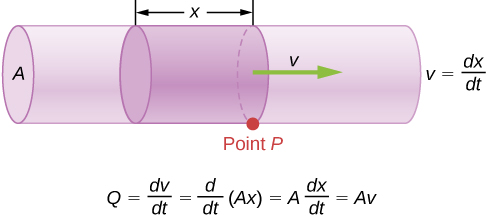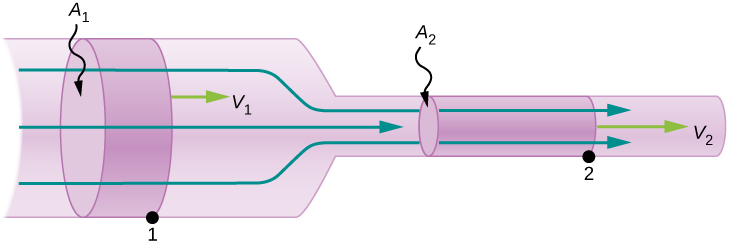| << Chapter < Page | Chapter >> Page > |
where V is the volume and t is the elapsed time. In [link] , the volume of the cylinder is Ax , so the flow rate is

The SI unit for flow rate is but several other units for Q are in common use, such as liters per minute (L/min). Note that a liter (L) is 1/1000 of a cubic meter or 1000 cubic centimeters
Flow rate and velocity are related, but quite different, physical quantities. To make the distinction clear, consider the flow rate of a river. The greater the velocity of the water, the greater the flow rate of the river. But flow rate also depends on the size and shape of the river. A rapid mountain stream carries far less water than the Amazon River in Brazil, for example. [link] illustrates the volume flow rate. The volume flow rate is where is the cross-sectional area of the pipe and v is the magnitude of the velocity.
The precise relationship between flow rate Q and average speed v is
where A is the cross-sectional area and is the average speed. The relationship tells us that flow rate is directly proportional to both the average speed of the fluid and the cross-sectional area of a river, pipe, or other conduit. The larger the conduit, the greater its cross-sectional area. [link] illustrates how this relationship is obtained. The shaded cylinder has a volume , which flows past the point P in a time t . Dividing both sides of this relationship by t gives
We note that and the average speed is . Thus the equation becomes .
[link] shows an incompressible fluid flowing along a pipe of decreasing radius. Because the fluid is incompressible, the same amount of fluid must flow past any point in the tube in a given time to ensure continuity of flow. The flow is continuous because they are no sources or sinks that add or remove mass, so the mass flowing into the pipe must be equal the mass flowing out of the pipe. In this case, because the cross-sectional area of the pipe decreases, the velocity must necessarily increase. This logic can be extended to say that the flow rate must be the same at all points along the pipe. In particular, for arbitrary points 1 and 2,
This is called the equation of continuity and is valid for any incompressible fluid (with constant density). The consequences of the equation of continuity can be observed when water flows from a hose into a narrow spray nozzle: It emerges with a large speed—that is the purpose of the nozzle. Conversely, when a river empties into one end of a reservoir, the water slows considerably, perhaps picking up speed again when it leaves the other end of the reservoir. In other words, speed increases when cross-sectional area decreases, and speed decreases when cross-sectional area increases.


Notification Switch
Would you like to follow the 'University physics volume 1' conversation and receive update notifications?